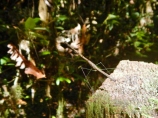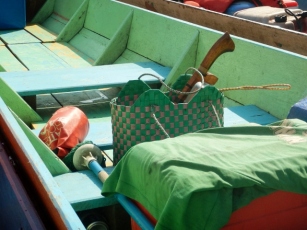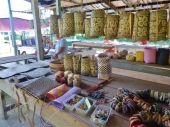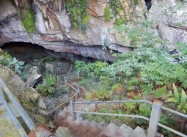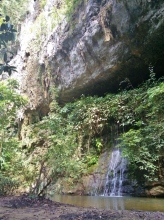As I write this, we are sitting at anchor in beautiful Buffalo Bay, on Koh Phayam in northern Thailand (very near the Myanmar border) and Chris is working on repairing our auto pilot. Trying to recollect the details of our adventures from ten months ago is definitely a challenge, but I am determined to try and bring our blog back up to date at some point. I know, I know…you’ve heard all that before.
March 13-16, 2019: We don’t normally do much land travel unless we have an option for Nukaat’s care. Lucky for us, not only did Trish and Will (Shanghai’d) offer to catsit for a few days so we could fly up into the Sarawak highlands and go to Gulang Mulu National Park, but they also carsat our Perodua rental and chauffeured us to and from the airport.
From Miri, it’s just a short flight to Mulu, with the only possible alternative being a slow trip upriver on a shallow-draft barge followed by a trek through the jungle on the Headhunters Trail, as there are no roads to the area. The flight highlights one of the big problems currently facing Borneo…the cutting of original forests to make way for yet more and more palm oil plantations. From high overhead, it’s also easy to see the snaky brown Melinau River wind through the highlands.
Everything comes in to Mulu by air, meaning things can be a little pricy. Mulu town, what there is of it, is tucked into a plateau between the airport runway and the Melinau River. The park is across the other side, accessed by a suspension bridge, and Brunei is just over there on the far side of the airport.
Our homestay, Mulu Village, was located a couple klicks from the airport, so we arranged a lift. Our hosts, James and Brenda, put us up in their traditional-style longhouse, fed us breakfast and shared their extensive knowledge of the area. Brenda is a licensed guide and James’ family history traces back many generations in the area.
After dropping our stuff, getting an overview from Brenda and signing up for one of her guided park tours the following morning, we decided to walk to town for some lunch and to check out Gunung Mulu National Park headquarters.
The park has been a world heritage site since 2005. The information centre provided us with a bunch of information and pamphlets outlining all the various options of things to do in the park, from guided tours through the showcaves, to multi-day hikes to Mount Mulu and the Pinnacles (razor sharp limestone spires) complete with leeches, and a variety of extreme caving expeditions.
Free options inside the park are limited, as most activities require a licensed guide, so we spent the afternoon checking out the Mulu Discovery Centre, walking along the extensive boardwalk system and the botanical loop, and checking out the jungle canopy from the high tower. We could have stayed to watch the evening bat exodus, but there were dark rainclouds looming so we decided to head back early and spent the afternoon lounging at the Mulu Marriott instead. We sat out one crazy downpour while enjoying mojitos on loungers overlooking the river scene below, where drenched tourists in bright orange lifejackets were returning from their guided trips up the river.
We found a funky little roadside restaurant right nearby our homestay and made a dash between showers to get there. The food included a number of regional delicacies and lots of grilled meat on sticks, plus the ubiquitous chicken rice. Bonus, they had lots of cold beer.
That night, Chris dropped off to sleep straight away. Meanwhile, I lay awake listening to the orchestra of insects outside our screened window. There was no way to turn down the volume, but eventually it turned into white noise and I drifted off.
The next day after breakfast, we joined Brenda’s walking tour to the first of the showcaves inside the park. Most of her guests from the homestay joined along too, so it was a bit of large group. Brenda pointed out several species of local flora and fauna, but most impressive were the bugs. They grow big in the rainforest. It’s no wonder there is so much bug music to keep me awake at night!
Mulu caves are both enormous and spectacular. The caves here are so large and extensive for three reasons. The cave making processes in tropical limestone karst formations are fast and aggressive due to the warm temperature of the water. High levels of rainfall mean enormous amounts of water flow into the limestone. The limestone at Mulu is fine grained and hard, so it doesn’t collapse easily and large caverns can form. (See what you learn when you read the signage posted around the caves.)
Today’s tour included Lang Cave and Deer Cave, ending up at the viewing area for the Bat Exodus.
Lang Cave: Lang Cave isn’t one of the biggest, but it is one of the most beautiful caves we saw in the park. It was discovered in 1977 by a local Berawan man named Lang Belarek. The trek through the cave is only 240 metres long, but there were plenty of stalactite, stalagmite and other cave formations to grab our attention.
Deer Cave (Luyang Payau): Deer cave is massive and goes on and on. The sheer scale of the place was a bit overwhelming and hard to photograph. It is home to millions of bats, and it definitely smells like it.
Bat Exodus: Lonely Planet describes the bat exodus as “spiralling clouds of bats that emerge from Deer Cave at dusk” and says this is one of the things not to miss at Mulu. Unfortunately for us, very few bats chose to join the bat exodus on the evening we attended and we only saw one tiny bunch head out. But we have seen the proof in videos and heard plenty of second-hand accounts. Maybe the rain last night threw off their echolocation or maybe they decided to take one of the cave’s other emergency exits instead.
The following day, with guide Brenda leading the way again, we were picked up at the jetty by the nearby Marriott for a trip upriver to see yet more caves. The river boats are long and low with a longtail-style prop shaft because the Melinau River gets pretty shallow in areas. One boatman is in charge of the engine, and a second boatman sits up front to pole our way upriver in places. He even had to get out from time to time to pull us upstream.
We made a stop at Batu Bungan, a Penan resettlement area, for a look at the local handicraft market. The Penan people are one of the last tribes of hunter-gatherers in the region and the government has been trying to resettle them outside their forest home in the park for some time, with varying degrees of success. The handicraft market is a livelihood project, offering a variety of woven items from mats to baskets, blowguns (their traditional method of hunting), and handmade trinkets. One elderly Penan man even demonstrated the method for boring out the centre of a long piece of wood to make a blowgun. It can take days to weeks to complete, depending on the length.
From here, we continued upstream to today’s showcaves, Cave of the Winds and Clearwater Cave.
Cave of the Winds: A river once ran through it, but nowadays we walked along the dry riverbed to reach the Kings Chamber with its spectacular stalactite and stalagmite formatations.
Clearwater Cave: Nearby Clearwater Cave is reached after climbing up and up a steep staircase. Once you get to the entrance at the top of the climb, you start your descent into the mouth of the cave. A crystal clear river flows through the cave and the types of formations here are quite different from the other caves.
After our cave walks, we had time for a quick swim in the Melinau River before it was time to reboard our boat for the run downriver.
The return was much quicker, and our boatmen soon had us back to the jetty where we first started. Our driver showed off his damaged prop, which I’m sure must be a regular occurrence on this stretch of water, although the water levels were reportedly lower than usual during our visit. (On the plus side, this meant we only had to endure a couple of heavy downpours during our stay, rather than endless rain.)
To round out our visit, we opted for the unguided trek to the Paku Waterfall, the only trek we did in the park that wasn’t on a boardwalk. The trail could be muddy and slippery and we always had to be on the lookout for tree roots, but fortunately there were no leeches.
On our last morning, we rented bikes from our homestay and pedaled along some of the seemingly forgotten roads which the jungle is doing a fabulous job of reclaiming. We also made another foray to the handicraft market to pick up a couple of souvenirs, including a woven basket with carrying straps to wear like a backpack and a small carved blowgun, because really, who doesn’t need a blowgun?
I should have figured the blowgun would pose a bit of a challenge at airport security later that day. Not to worry, we simply checked the blowgun and collected it upon our arrival in Miri, where we were super excited to see Nukaat, but he seemed wholly uninterested in our return. Maybe he never even noticed we were gone. Extra special thanks to Trish and Will for taking such good care of our fur baby.
Next up, we finally leave Borneo for the fabled Anambas Islands in Indonesia.



















